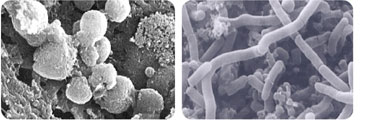| Extremophiles can be classified according
to the conditions in which they exist:
Thermophiles:
Microorganisms having a growth temperature optimum of 50°C
or higher. They are found in hot springs and other hot environments.
Hyperthermophiles:
Microorganisms having a growth temperature optimum of 80 °C
and above. They live in deep-sea vents and hot springs.
Halophiles:
Microorganisms that live in salty environments. According
to their salt requirements, moderate Halophiles grow between
2% and 5% salt concentrations (0.2-0.85 M) and extreme Halophiles
grow optimally at salt concentrations above 20% (3.4-5.1M).
They live in places like salt lakes and salt mines.
Acidophiles:
Microorganisms with a growth optimum at or below pH 2. They
live in places like sulphur springs or acidic mine waters.
Alkaliphiles:
Microorganisms with optimal growth at pH above 10. They are
found in places like soda lakes.
Psychrophiles:
Microorganisms having an optimum growth temperature of 15°C
or lower, some can survive at -10°C and are unable to
grow above 20°C. They are found in sea ice as much as
in Arctic and Antarctic ice packs.
Piezophiles:
Microorganisms that live optimally at high hydrostatic pressures
(up to 130 MPa). They are found in deep-sea hydrothermal vents.
(Previously termed barophiles)
Xerophiles:
Microorganisms resisting extremely dry environments, like
for example the Chilean Atacama desert. |


